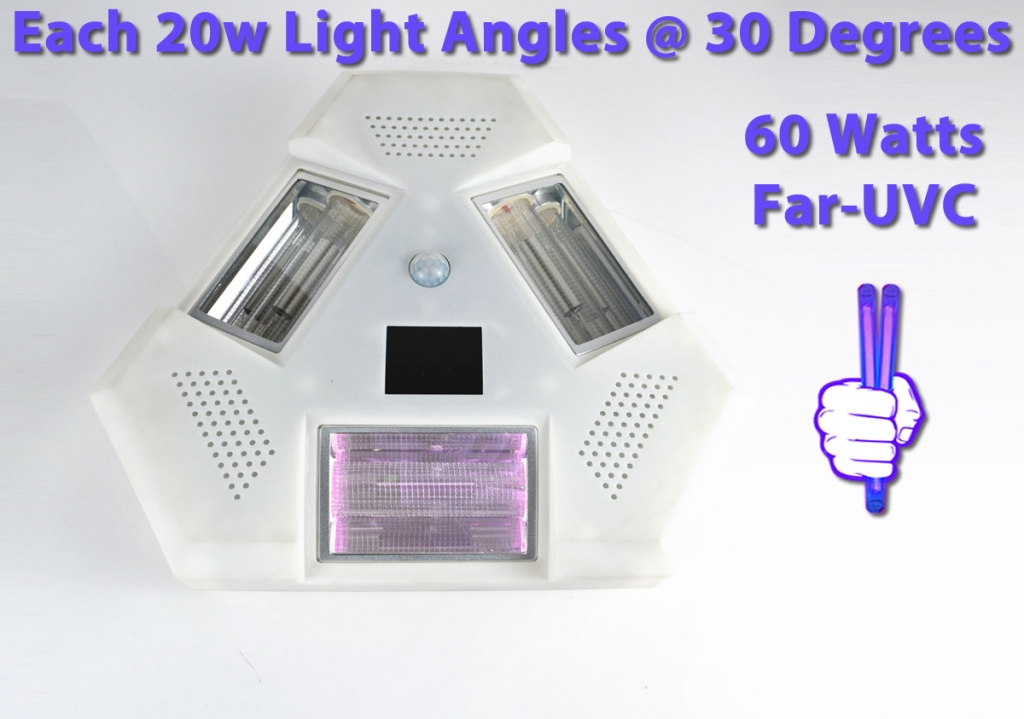

Ultraviolet (UV) light exposure is a direct antimicrobial approach 4 and its effectiveness against different strains of airborne viruses has long been established 5.

Given the rapid spread of the disease, including through asymptomatic carriers 3, it is of clear importance to explore practical mitigation technologies that can inactivate the airborne virus in public locations and thus limit airborne transmission. Transmission of SARS-CoV-2, the beta coronavirus causing COVID-19, is believed to be both through direct contact and airborne routes, and studies of SARS-CoV-2 stability have shown viability in aerosols for at least 3 hours 2. Despite extensive efforts to contain the spread of the disease, it has spread worldwide with over 5.3 million confirmed cases and over 340,000 confirmed deaths as of 1. Thus while staying within current regulatory dose limits, low-dose-rate far-UVC exposure can potentially safely provide a major reduction in the ambient level of airborne coronaviruses in occupied public locations.Ĭoronavirus disease 2019 (COVID-19) was first reported in December 2019 and then characterized as a pandemic by the World Health Organization on March 11, 2020. Based on the beta-HCoV-OC43 results, continuous far-UVC exposure in occupied public locations at the current regulatory exposure limit (~3 mJ/cm 2/hour) would result in ~90% viral inactivation in ~8 minutes, 95% in ~11 minutes, 99% in ~16 minutes and 99.9% inactivation in ~25 minutes. As all human coronaviruses have similar genomic sizes, far-UVC light would be expected to show similar inactivation efficiency against other human coronaviruses including SARS-CoV-2. Low doses of 1.7 and 1.2 mJ/cm 2 inactivated 99.9% of aerosolized coronavirus 229E and OC43, respectively. We previously demonstrated that 222-nm far-UVC light efficiently kills airborne influenza virus and we extend those studies to explore far-UVC efficacy against airborne human coronaviruses alpha HCoV-229E and beta HCoV-OC43. By contrast, far-UVC light (207–222 nm) efficiently kills pathogens potentially without harm to exposed human tissues.
#Far uvc lamp skin#
Germicidal ultraviolet light, typically at 254 nm, is effective in this context but, used directly, can be a health hazard to skin and eyes. Several Sentara facilities use copper surfaces and copper-infused products.A direct approach to limit airborne viral transmissions is to inactivate them within a short time of their production.
#Far uvc lamp trial#
Sentara pointed to its clinical trial from a few years back that found copper can fight against hospital-acquired infections. The process, however, only begins after people have left the space. However, in 2020, Riverside Regional Medical Center in Newport News began utilizing a robot that uses an ultraviolet light pulse that disinfects a 360-degree space. Riverside Health System responded that it is not, at this point. News 3 reached out to Hampton Roads-based health systems to find out if they're looking into using it in their facilities. The technology is still in the testing phase, Brenner says. "I think what we have achieved with FAR-UVC is the equivalent of stepping outside." "Where are we transmitting COVID? Where are we transmitting influenza? It's almost entirely indoors because you have so much ventilation outdoors," Brenner told CBS News. David Brenner, the director of the Center for Radiological Research at Columbia, says the technology could find use in not only hospitals, but airplanes and schools. According to researchers, it kills 98 percent of indoor airborne microbes in around five minutes.ĭr. Scientists at Columbia University say a certain type of ultraviolet light, Far-UVC light, can kill viruses and bacteria while leaving people unharmed.Ĭolumbia dental students are currently working under Far-UVC lamps that work to disinfect the air. The transmission of viruses like COVID-19 or the flu is more likely indoors than outside, but there's new technology in development aiming to make the inside just as safe as open air. Whether you're in the doctor's office or even the grocery store, it's hard to know what's floating around in the air there.


 0 kommentar(er)
0 kommentar(er)
